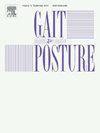Effects of carbon fiber custom dynamic orthosis stiffness on lower limb motion and loading during gait: A pilot study
IF 2.2
3区 医学
Q3 NEUROSCIENCES
引用次数: 0
Abstract
Background
Traumatic lower limb injuries can have long-lasting detrimental effects. Carbon fiber custom dynamic orthoses (CDOs) are used to improve function, reduce pain, and alter foot loading following such injuries. Most prior investigations in this area have focused on very stiff CDOs designed to return patients back to physically demanding activities, with few studies evaluating more compliant CDOs.
Research question
Does CDO stiffness influence gait kinematics and kinetics, ground reaction forces, and forces acting on the foot in individuals following traumatic injury.
Methods
Seven individuals who had sustained a unilateral distal tibia intra-articular fracture completed testing without an orthosis and in three CDOs of differing stiffnesses (Compliant, Moderate, Stiff). Biomechanical gait data were collected while participants walked at a controlled speed. Instrumented insoles were used to measure peak forces and force impulse for the hindfoot, midfoot, forefoot, and total foot.
Results
Significant effects on joint kinematics and kinetics were primarily observed at the ankle. All CDOs significantly reduced ankle motion and power compared to walking without a CDO. Moderate and Stiff CDOs both significantly reduced knee flexion at initial contact. All CDOs significantly reduced peak medial and braking ground reaction forces compared to walking without a CDO. Peak hindfoot force was significantly reduced with Compliant and Stiff CDOs. Peak forefoot force and forefoot force impulse were significantly reduced with all CDOs. Large effect sizes were observed for most significant pairwise comparisons.
Significance
Study CDOs similarly reduced ankle motion while allowing greater power generation compared to very stiff CDOs in previous publications. Peak hindfoot force, peak forefoot force, and forefoot force impulse were significantly reduced with CDO use. The limited effect of CDO stiffness on outcomes suggests that more compliant CDOs may be sufficient in individuals where pain with motion and loading is a primary consideration following traumatic injury.
碳纤维定制动态矫形器刚度对步态中下肢运动和负荷的影响:一项初步研究
背景:创伤性下肢损伤会产生长期的有害影响。碳纤维定制动态矫形器(CDOs)用于改善功能,减轻疼痛,并改变足部损伤后的负荷。该领域的大多数先前研究都集中在旨在使患者恢复体力活动的非常僵硬的cdo上,很少有研究评估更顺从的cdo。研究问题:在创伤性损伤后,CDO刚度是否影响步态运动学和动力学、地面反作用力以及作用于足部的力?方法7例单侧胫骨远端关节内骨折患者在没有矫形器的情况下完成了三种不同刚度(柔顺、中等、僵硬)的cdo的测试。当参与者以受控速度行走时,收集生物力学步态数据。测量鞋垫测量后足、中足、前足和全足的峰值力和力脉冲。结果对关节运动学和动力学的显著影响主要发生在踝关节。与不带CDO的步行相比,所有CDO都显著减少了脚踝的运动和力量。中度和僵硬cdo在初次接触时均可显著降低膝关节屈曲。与不带CDO行走相比,所有CDO都显著降低了峰值内侧和制动地面反作用力。柔性和刚性cdo显著降低了峰值后脚力。所有cdo均显著降低了前足力峰值和前足力冲量。在大多数显著的两两比较中观察到较大的效应量。与之前发表的非常僵硬的cdo相比,研究cdo同样减少了脚踝运动,同时允许更大的发电量。峰值后足力、峰值前足力和前足力冲量随着CDO的使用而显著降低。CDO刚度对结果的有限影响表明,对于那些运动和负荷疼痛是创伤性损伤后主要考虑因素的个体,更顺从的CDO可能就足够了。
本文章由计算机程序翻译,如有差异,请以英文原文为准。
求助全文
约1分钟内获得全文
求助全文
来源期刊

Gait & posture
医学-神经科学
CiteScore
4.70
自引率
12.50%
发文量
616
审稿时长
6 months
期刊介绍:
Gait & Posture is a vehicle for the publication of up-to-date basic and clinical research on all aspects of locomotion and balance.
The topics covered include: Techniques for the measurement of gait and posture, and the standardization of results presentation; Studies of normal and pathological gait; Treatment of gait and postural abnormalities; Biomechanical and theoretical approaches to gait and posture; Mathematical models of joint and muscle mechanics; Neurological and musculoskeletal function in gait and posture; The evolution of upright posture and bipedal locomotion; Adaptations of carrying loads, walking on uneven surfaces, climbing stairs etc; spinal biomechanics only if they are directly related to gait and/or posture and are of general interest to our readers; The effect of aging and development on gait and posture; Psychological and cultural aspects of gait; Patient education.
 求助内容:
求助内容: 应助结果提醒方式:
应助结果提醒方式:


